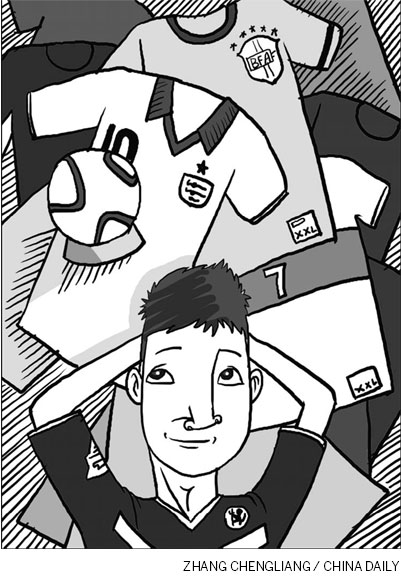Comment
Will China be the next major market for sports collectibles?
By Bobby Brill (China Daily)
Updated: 2010-07-14 09:54
 |
Large Medium Small |

With the World Cup just ended and Beijing bars still full of Ronaldo, Maradona and Landon Donovan jerseys, sports merchandisers and marketers are blowing their own vuvuzelas in celebration of the growing Chinese consumer market. Many international marketers are convinced that Chinese fans are contributing a lot to the world's multi-billion dollar sports merchandising business.
China is already a huge market for apparel and celebrity endorsed goods, but some think the country may also be a big market for trading cards, autographed equipment and sports art.
The mother of all merchandising events was, of course, the Olympics; here in Beijing in 2008, anything with a Fuwa emblazoned on it flew off the shelves.
World Cup 2010 merchandise seems equally as popular in the retail stores of China. However, some smaller international sports events provide better insight into how Chinese consumers spend their money on sports goods.
In March of 2008, Major League Baseball (MLB) held it's first ever game in China at the Wukesong Olympic Stadium and panda bear dolls wearing commemorative jerseys, official baseballs with the historic date and apparel were sold to nearly everyone in attendance.
"They didn't hesitate and made quick decisions when purchasing the goods. Many customers wanted to buy more," said Charles Ko, the managing director of Eversports Marketing Ltd, the company in charge of the souvenir concessions.
Sports fans the world over are big collectors; every fan has at least a jersey or two or some sort of commemorative piece of memorabilia and in the US, no kid grows up without buying baseball cards. At a recent auction in the US, one baseball card sold for over $2 million.
That's a lot for a little piece of cardboard, almost the equivalent to the prices top Chinese art fetches at auctions houses around the world.
The Chinese art market generated close to $4 billion between 2000 and 2009. The sports memorabilia market in the US generates around $5 billion a year. These two markets are highly speculative and rely on "super stars" to drive them. But does this mean the Chinese people are willing to spend their hard-earned money on sports collectibles?
Some certainly seem to think so.
"Through the China Series (the MLB game), we have come to feel that Chinese fans are potential big spenders. We cannot underestimate them," said Ko.
As disposable incomes and the number of wealthy people in China continue to rise, the idea of purchasing something such as a $3,000 autographed Michael Jordan basketball as an investment will likely only become more popular.
"Chinese fans are clever. They fancy collecting their favorite souvenirs because they know in the future these souvenirs will become their own treasure and will bring them big surprises in value," said Ko.
While collectibles in the US are becoming a harder sell in a stagnant economy, there are plenty of sports fans here in China. Marketers are aware and excited that China has weathered the financial storm better than most countries. This financial stability will help keep the number of sports fans in China growing.
The Chinese market is ready for collectibles, but marketers of such goods need to be patient.
"This is a very niche market," said Aaron Randolph, director of sales and marketing for IMG, China, a major sports and entertainment marketing and event management company.
However, he was quick to add that in China a niche market can still be millions of people.
"You're not doing too bad if you are hitting 2 percent or 3 percent of 1.3 billion consumers," said Randolph.